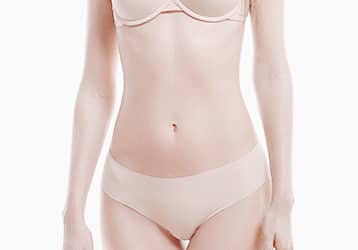Enhance Your Leg Contours: Thigh Lift Surgery in Ohio

Overview
The thighs are one of the most stubborn areas of the body, often resistant to exercise and diet. It is affected by factors such as aging, gravity, excess weight gain, hormonal changes, loss of skin elasticity or a combination of these issues, causing the skin to become lax while the thighs accumulate fat and cellulite.
Thigh lift, or thighplasty is a good option if you are looking to improve the contour and appearance of your thighs. This procedure helps eliminate excess, sagging skin as well as unwanted fat and tissues that make your thighs appear heavy and out of shape.
If you are based in Ohio, Indiana, Kentucky, or anywhere in the Midwest, the team at Midwest Breast & Aesthetic Surgery is here to restore your thighs to its youthful appearance!
Cost and Financing
The total cost of your thigh lift depends on several factors, which will be discussed during your consultation. These factors include:
- Amount and location of the excess skin, fat, and tissues to be removed
- Diagnostic tests needed before surgery Your overall health and medical conditions
- Qualifications and experience of the plastic surgeon and surgical technique
- Location of surgery: Hospital, aesthetic center, or clinic facilities
- Choice of anesthesia or sedation
- Post-operative medications and supplies
- Any other surgical procedures combined with your thigh lift surgery
- Follow-up visits
Most insurance companies do not cover the expenses for a thigh lift, unless there is a medical necessity based on the insurance company criteria. In certain circumstances, the procedure may be covered if it is considered vital following massive weight loss or bariatric surgery. Each individual insurance policy is unique and you are encouraged to inquire with your insurance agent for details.
Benefits of Thigh Lift
Our legs, particularly the thighs, are often resistant to improvement through diet and exercise. Most patients undergo the thigh lift procedure because they want to get rid of this excess, drooping skin in their thighs.
The procedure effectively eliminates most of the sagging skin in your thighs, providing you with better leg shape that is more proportional to the rest of your body. The procedure can significantly improve your figure and boost your self-confidence.
With the noticeable decrease in leg circumference, you may enjoy larger options for better-fitted clothing. A thigh lift may not only address aesthetic issues from massive weight loss or bariatric surgery, but it may also alleviate the following conditions:
- Skin irritations such as rashes and ulcers that may lead to infection
- Hygiene problems
- Problems with leg movement
Types
Inner Thigh Lift
The inner, or medial thigh lift is the most popular procedure. It targets the excess skin on the upper section of the inner thigh. Incisions are made near the groin and may extend to the back of the buttock creases or the hip region. This allows the underlying tissues and fat to be accessible while keeping the incision and its resulting scar hidden.
In order to treat larger areas of excess thigh skin, a vertical incision may be needed. This leaves a scar down the inner thigh towards the knee. A mini-thigh lift is a modification of this procedure, which targets only the upper one-third of the inner thigh. The mini thigh lift has minimal scarring and downtime, but its outcome may not be as dramatic as the actual inner thigh lift.
Outer Thigh Lift
Also known as the lateral thigh lift, the outer thigh lift is fashioned to tighten the skin on the front and side of the thigh. The procedure involves incisions from the groin crease upwards to the hip, forming a V-shaped pattern. This incision allows the resulting scar to be hidden under clothing and most swimwear. The outer thigh lift can remove a larger portion of excess skin and lift the buttocks as well.
Spiral Thigh Lift
A newer technique, the spiral thigh lift refines the front, back, inner, and outer thigh circumferentially. It involves incisions made below the buttocks and extends to the groin crease. This procedure addresses the vertical laxity around the entire thigh.
Vertical Thigh Lift
The vertical thigh lift reshapes the mid and lower thigh in a transverse or circumferential manner. It involves an incision made from the groin crease that extends to the inside portion of the knee, removing a large area of the excess skin and tissues. This procedure produces a scar that is more difficult to conceal under some clothes.
Before the Surgery
The initial consultation is an opportunity to discuss and plan the entire surgical process. We begin by determining your suitability for a thigh lift through a review of your medical history and a physical examination.
You must be willing to answer questions about the current state of your health. We will discuss your goals and preferences during this visit.
During the consultation, we will:
- Describe the procedure in detail.
- Discuss treatment options and the expected outcome, depending on the chosen surgical technique.
- Provide before and after photos to help guide your preferences.
- Explain the risks, side effects, and complications associated with the procedure.
- Discuss the necessary preparations and post-operative instructions.
- Discuss available payment and financing options.
- Address all questions and concerns about your thigh lift procedure.
Preparing for the Surgery
Preparing for surgery is important to ensure an excellent outcome while decreasing the possibility of complications.
We advise patients to stop smoking and drinking at least two months before surgery to promote good wound healing.
Likewise, we advise against taking medications (e.g. aspirin, non-steroidal anti-inflammatory drugs) and health supplements that lead to excess bleeding and bruising. However, do not discontinue prescribed medications without consulting with our surgeons and the primary care doctors who prescribed them.
In addition, you should:
- Wash your thighs daily with soap and water in the weeks leading up to surgery.
- Eat well and maintain a healthy and stable weight.
- Get plenty of rest to aid in recovery.
- Stay well hydrated before and after the surgery.
- Avoid eating/drinking eight hours before your surgery.
- Plan for and arrange time off from work.
- Obtain and fill prescriptions before surgery (i.e. pain medicine and antibiotics).
- Purchase medical supplies (e.g. bandages, gauzes, compression garments).
During the Surgery
We may provide the option to choose between general anesthesia, local anesthesia, and intravenous sedation. However, most patients are required to take general anesthesia for this procedure.
The incisions for surgery are based on the type of thigh lift we have agreed to perform during your consultation. Through these incisions, the loose skin is removed. In some cases, we may incorporate a liposuction procedure to remove unwanted fat deposits in your thighs.
After removing the extra skin and fat, the remaining skin is pulled together and closed using sutures. This helps to form and support the new contour of your thighs.
Drains will be placed in your wounds to prevent fluid build-up and possible infection. On average, thigh lift surgery may last for two to four hours.
Request Your Consultation
To learn more about thigh lift, you can schedule an appointment online or you can call 855-687-6227
Recovery
Right after surgery, your surgical wounds are bandaged and drains are attached to a suction bulb to remove excess fluids. You will feel sore, and there will be swelling and bruising in your thighs, which lasts for two to five weeks with gradual improvement. It is advised that you do not sit on your thighs to avoid pressure on your wounds. You can use a pillow between your legs at night time to relieve the pressure on your thigh incisions.
On the first day after surgery, you are advised to keep a liquid diet. We recommend taking short walks around to promote blood circulation, and limit the possibility of forming blood clots. You should avoid climbing stairs or participating in other strenuous activities.
A week after the surgery, sutures and drains are removed during your follow-up visit. In two to three weeks, you should be able to return to work. It is recommended to continue wearing a compression garment to protect your incisions and allow the wounds to heal appropriately.
Activity Limitations
During the first week, we suggest bending your legs slightly to help lessen the pain, tension, and scarring. You should also wrap the groin area with gauze to keep it dry from sweat.
Patients are advised to limit lifting anything more than 10 lbs, exercising, and other strenuous activities for six to eight weeks. Full and complete recovery will require six months to a year.
For an appropriate and worry-free recovery, it is important to follow the post-operative and aftercare instructions that we provide during your initial consultation.
Risks and Complications
While the thigh lift is a relatively safe procedure, it has risks and possible complications that include:
- Swelling, bruising, and soreness
- Prolonged pain, discomfort, and numbness
- Infection
- Bleeding
- Scarring
- Delayed wound healing or tissue necrosis
- Accumulation of fluid (seroma) and blood (hematoma) under the skin that may require surgical evacuation
- Asymmetry and unsatisfactory results that may require revision surgery
- Adverse reactions to anesthesia
- Allergic reactions to medications or medical supplies
- Deep vein thrombosis, or blood clots in the legs that can migrate to the lungs.
If these side effects or complications are present, please contact our office. In certain situations, we may advise you to go to the nearest hospital for examination and possible hospital admission.
Results
Once the swelling and bruising subside, your thighs will be noticeably slimmer, with a more youthful appearance and contour.
It may take up to a year for final results to appear. Results are long lasting, especially if a healthy lifestyle and stable weight is maintained. With natural aging, your skin may lose its firmness but the primary improvements should remain.
Thigh Lift Scarring
While a thigh lift is effective in addressing the aesthetic issues in your thigh and upper leg, it heals with visible scars. These incisions are strategically placed to conceal the resulting scars under your clothes.
For methods like the mini and vertical thigh lift, the resulting scars may be difficult to hide. It is important to understand each of the techniques and discuss all concerns with your surgeon.
Are You a Good Candidate for Thigh Lift Surgery?
You may be a candidate for thigh lift surgery if you:
- Have sagging skin in your thighs
- Have excess skin and unwanted fat deposits that do not improve with exercise and diet
- Can maintain a stable weight
- Are in good overall health
- Do not smoke or drink excessively
- Have realistic expectations and goals for the procedure
- Are mentally healthy
- Maintain a healthy lifestyle (regular exercise and good nutrition)
If you are diabetic, pregnant, or a heavy smoker and drinker, surgery is not recommended as these conditions increase the risk of complications and affect your healing and recovery.
How to Choose a Thigh Lift Surgeon in Ohio?
The success of your thigh lift relies on your plastic surgeon’s skill in performing the surgery. It is important to check the qualifications of the surgeon you are consulting with; including his/her training and experience.
Here are a few questions that you should ask your plastic surgeon:
- Are you certified by the American Board of Plastic Surgeons or other similar accrediting organization?
- How often do you perform this procedure?
- How long have you been performing this procedure?
- What is your success rate in performing a thigh lift?
- Do you have before and after photos of previous patients and/or patient evaluations?
- Where do you perform the procedure? Is the facility properly accredited and state-licensed?
- Do you have operating privileges at an accredited hospital in case of emergency?
Frequently Asked Questions
1. How long does a thigh lift last?
A thigh lift is a permanent solution to remove excess skin and fat on your thighs. However, results differ from patient to patient and depend on the technique used to perform the thigh lift. The outcome should be long-lasting if you maintain a healthy lifestyle and stable weight.
2. Are the resulting scars permanent?
Scars are an inevitable trade-off for removing large portions of the skin on the thigh. The resulting scars are permanent.
However, incision sites can be strategically placed, so as to hide the resulting scars under your clothes. Improvements in scar appearance will be noticeable within four to six weeks after surgery and scar remodeling will continue over the ensuing year.
3. Can I combine the thigh lift with other body contouring procedures?
A thigh lift can be combined with other body contouring procedures such as liposuction and buttock lift for more impactful results and an improved body contour. Combining procedures may increase the risks of complications. Discuss the benefits and risks with your surgeon.
4. How soon can I shower after the surgery?
Showers can be taken on the third day after surgery. Baths are not allowed until all wounds have healed completely.
5. When can I start driving again?
You may resume driving after two to three weeks. We recommend waiting until you are no longer taking pain medications. It is illegal to drive under the influence of prescription pain medicine.
*The information available on this page was created to educate our patients. It is not an alternative for a formal consultation with a board-certified plastic and reconstructive surgeon. Individual results vary per patient. For more information, we strongly recommend scheduling a consultation with our doctors.



